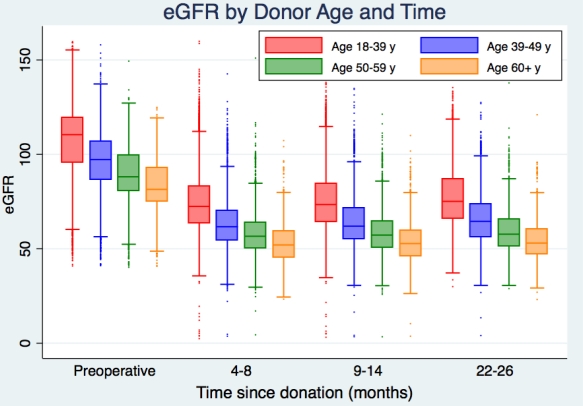Short-Term Post-Donation Renal Function in Living Kidney Donors.
JHU, Baltimore.
Meeting: 2016 American Transplant Congress
Abstract number: 48
Keywords: Donation, Renal function
Session Information
Session Name: Concurrent Session: Living Kidney Donation: Risk Factors for Adverse Long term Outcome
Session Type: Concurrent Session
Date: Sunday, June 12, 2016
Session Time: 2:30pm-4:00pm
 Presentation Time: 2:30pm-2:42pm
Presentation Time: 2:30pm-2:42pm
Location: Veterans Auditorium
Previous single-center studies of post-donation estimated glomerular filtration rate (eGFR) in living kidney donors were limited by small sample size and lack of generalizability. The goal of our study is to investigate the association between preoperative donor characteristics and post-donation eGFR using national SRTR data.
METHODS: We studied eGFR in the 2 years post-donation in 35,886 donors between 2006-2015. We modeled post-donation eGFR as % of preoperative eGFR initial decline and then recovery. We used multilevel mixed-effects linear regression to account for multiple post-donation eGFR measurements per donor.
RESULTS: The median (IQR) initial 6-month decline was 34.6 (26.5-41.2)%. In an adjusted model, higher age, BMI, systolic blood pressure (SBP), educational level, African-Americans (AA), and males were associated with sharper declines (all p<0.01). Following the initial drop, % eGFR recovery increased per year by 1.952.142.32% for donors aged 18-39, and 1.211.622.03% for donors aged 60+ (age/time interaction p<0.001). AA were associated with 1.871.451.03% decrease, and Hispanics were associated with 1.231.612.00% increase in % eGFR recovery compared to Whites, respectively (all p<0.001). Higher BMI, SBP, educational level, smoking, and males were associated with lower % eGFR recovery (all p<0.05).
CONCLUSION: Post-donation eGFR decline and recovery varies based on donor characteristics. Younger donors have more rapid short-term post-donation eGFR recovery.
| Adjusted model of post-donation eGFR recovery | |
| Donor Characteristics | Difference in % eGFR recovery |
|
Per year of follow-up for ages 18-39y 40-49 50-59 60+
|
. 1.952.142.32 1.321.531.74 0.981.211.45 1.211.622.03
|
|
Male
|
-1.79-1.52-1.26 |
|
African-American (vs White) Hispanic Other |
-1.87-1.45-1.03 1.231.612.00 -0.64-0.040.57 |
|
Attended College (vs ≤ High School) College Graduate Post College |
-0.97-0.64-0.31 -1.33-1.00-0.67 -1.69-1.26-0.84 |
|
BMI <24 (vs 25-29) kg/m2 30+ |
0.801.091.38 -0.62-0.290.03 |
|
SBP 120-139 (vs <120) mmHg 140+ |
-0.78-0.51-0.24 -0.61-0.110.38 |
|
Smoker
|
-0.59-0.30-0.01 |
| Bold: p-value<0.05 | |

CITATION INFORMATION: Fahmy L, Massie A, Muzaale A, Sandal S, Chow E, Segev D. Short-Term Post-Donation Renal Function in Living Kidney Donors. Am J Transplant. 2016;16 (suppl 3).
To cite this abstract in AMA style:
Fahmy L, Massie A, Muzaale A, Sandal S, Chow E, Segev D. Short-Term Post-Donation Renal Function in Living Kidney Donors. [abstract]. Am J Transplant. 2016; 16 (suppl 3). https://atcmeetingabstracts.com/abstract/short-term-post-donation-renal-function-in-living-kidney-donors/. Accessed December 25, 2025.« Back to 2016 American Transplant Congress
